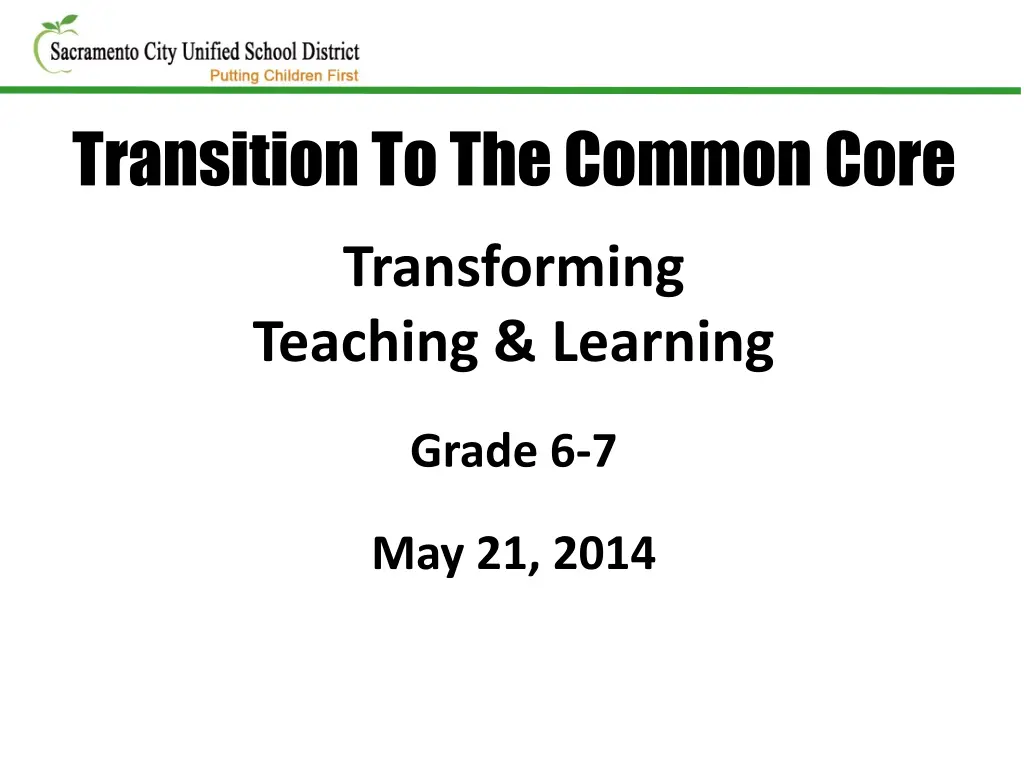
Transforming Teaching & Learning Through Common Core Integration
Explore the transition to the Common Core curriculum for grades 6-7 with a focus on mathematical concepts like proportional reasoning and problem-solving strategies. Participants will connect standards to pedagogy, analyze assessments, and plan instructional strategies.
Download Presentation

Please find below an Image/Link to download the presentation.
The content on the website is provided AS IS for your information and personal use only. It may not be sold, licensed, or shared on other websites without obtaining consent from the author. If you encounter any issues during the download, it is possible that the publisher has removed the file from their server.
You are allowed to download the files provided on this website for personal or commercial use, subject to the condition that they are used lawfully. All files are the property of their respective owners.
The content on the website is provided AS IS for your information and personal use only. It may not be sold, licensed, or shared on other websites without obtaining consent from the author.
E N D
Presentation Transcript
Transition To The Common Core Transforming Teaching & Learning Grade 6-7 May 21, 2014
Warm Up For every $5.00, two pounds of strawberries can be purchased. How much will it cost to purchase 9 pounds of strawberries? The tape diagram below is a model that represents the relationship between the two different quantities; dollars and pounds of strawberries. Dollars Pounds Use a tape diagram model to determine the cost of 9 pounds of strawberries. Try to think of at least two different ways.
Modeling 6.RP and 7.RP How could you use the tape diagram model to determine the cost of 1 pound (unit rate) of strawberries? How does the use of the tape diagram support proportional reasoning? Table of Equivalent Ratios
Modeling 6.RP and 7.RP Double Number Lines Equations Coordinate Plane
Outcomes Participants will: Connect content standards to content pedagogy. Celebrate successes. Translate SBAC practice and field test observations to instructional implications. Analyze the curriculum map and use it to plan for coherent, cohesive and connected instruction.
Agenda 1. Warm-Up 2. Celebrating Success 3. SBAC Assessment Analysis 4. Curriculum Maps
Celebrate Success Share Your Common Core Story Growth vs. Fixed Mindset Formative Assessment Feedback that moves Learning Forward Talk Moves/Productive Talk Open-Ended Questions Standards for Mathematical Practice Today s Number Tell Me All You Know About Problem-Solving Strategies My Favorite No Valuing Wrong Answers Backward Lesson Design Number Lines Content Analysis Wikispace
SBAC Assessment What were you pleased to see? What instructional implications are indicated? What was familiar to you? What surprised you?
Curriculum Maps What Are They? Independently study the curriculum map Then answer Questions 1 and 2 on Curriculum Map Guiding Questions sheet. Benefits of Curriculum Maps Unit 1 Examine it more closely and use your observations to answer Question 3.
Directions for After the Break 3 Corners - Rich, Nick, Joy 6th grade Joy s Corner - All 7th grade Rich s Corner Fern Bacon, Einstein, Cal, Rosa Parks, A.M. Winn, Fr. Keith B. Kenny, John Still, Leonardo da Vinci 7th grade Nick s Corner SES, John Morse ,Wood, Brannon, Sutter, Kit Carson, Alice Birney, Genevieve Didion, Martin L. King, Jr
Curriculum Maps How are They Used to Plan for Instruction? Two objectives: Model the process of using the curriculum map to prepare for creating a learning unit and lesson planning. Provide feedback on the curriculum map Use Plus/Delta Recording Sheet
Why Plan Units of Study? Think, Pair, Share Think Using Why Plan Units of Study sheet, prioritize the benefits by selecting your personal Top 3. Pair Share your Top 3 and your reasons for the selections with another person at your table. Share Share with whole group.
Why Plan Units of Study? In short You can t outsource your thinking to anyone or anything!
Curriculum Maps How are They Used to Plan for Instruction? Unit 1 Close Reading Read with a pen Content Analysis 1. Read the actual complete text of the standards to which this unit is aligned. 2. Use Resource column study standards support tools to deepen understanding of what the content standards mean
Curriculum Maps How are They Used to Plan for Instruction? Unit 1 Answer the essential questions Do the items/tasks in the assessment column Examine/Analyze the Sequence of Learning Experiences and the Instructional Strategies use them to create a cohesive and connected sequence of lessons
Curriculum Maps How are They Used to Plan for Instruction? Unit 1 Fully develop one lesson of the sequence incorporating at least specific instructional or content pedagogy strategy learned this year. Use SCUSD Lesson Plan Template as a guide. Share with your training specialist for posting on the wikispace before leaving today.
Curriculum Maps How are They Used to Plan for Instruction? March Content Analysis 1. Find the unit aligned to the content cluster which you studied in March. 2. Use a second +/ to provide feedback.
Moving Forward - CCSSM What are the obstacles/possible solutions to implementing curriculum maps? - In your classroom? - In your grade? - In your school?
Moving Forward Teachers are the key to children s math learning, the conduits between the child and the math curriculum. Marilyn Burns, Leading The Way






















